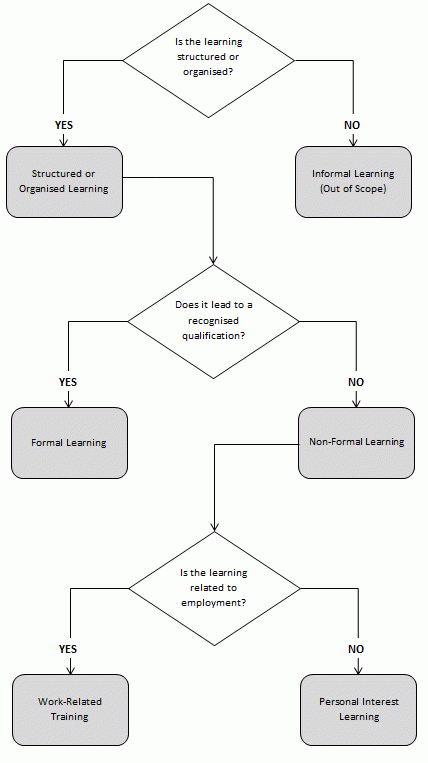The Survey of Work-Related Training and Adult Learning (WRTAL) was collected throughout Australia from July 2016 to June 2017.
- Four in ten (40.9%) Australians aged 15-74 years participated in formal and/or non-formal learning in 2016-17. Participation has decreased since the last survey in 2013 (46.4%) and since 2005 (48.9%).
- More men than women participated in formal and/or non-formal learning in 2005. By 2013, participation was higher for women than men, and this continues to be the case in 2016-17.
- One in two (50.5%) men participated in 2005, decreasing to 45.1% in 2013 and then to 39.4% in 2016-17. Women's participation rate was relatively stable between 2005 (47.2%) and 2013 (47.7%) but then fell to 42.3% in 2016-17.
- Participation in formal and/or non-formal learning in 2016-17 was higher for people who were working or unemployed (in the labour force) (46.1%) than for those not in the labour force (28.1%). However, participation by people in the labour force has decreased from the rates recorded in 2005 (59.1%) and then in 2013 (53.1%) to 46.1% in 2016-17. In comparison, participation by people not in the labour force increased from 2005 (25.2%) to 2013 (29.9%) but then decreased in 2016-17 (28.1%).
Table 1 - Formal and/or non-formal learning, Australia, 2005, 2013 and 2016-17(a)
| Indicator | Year(b)(c) | Differences | ||||||
|---|---|---|---|---|---|---|---|---|
| 2005 | 2013 | 2016-17(d) | 2005 to 2016-17 | 2013 to 2016-17 | ||||
| Formal and/or non-formal learning(a) | ||||||||
| Persons | 48.9% | 46.4% | 40.9% | -8.0pts | -5.5pts | |||
| Males | 50.5% | 45.1% | 39.4% | -11.1pts | -5.7pts | |||
| Females | 47.2% | 47.7% | 42.3% | -4.9pts | -5.4pts | |||
| Age groups | ||||||||
| 15 to 64 years | 53.4% | 50.2% | 44.8% | -8.6pts | -5.4pts | |||
| 15 to 24 years | 77.8% | 78.1% | 76.1% | (e)1.7pts | (e)-2.0pts | |||
| 15 to 19 years | 87.2% | 90.5% | 89.9% | 2.7pts | -0.6pts | |||
| % of persons aged 15 to 19 years currently studying for Year 12 or below | 52.5% | 53.5% | 61.0% | 8.5pts | 7.5pts | |||
| 20 to 24 years | 68.7% | 67.0% | 63.8% | -4.9pts | -3.2pts | |||
| 25 to 34 years | 55.5% | 51.0% | 44.6% | -10.9pts | -6.4pts | |||
| 35 to 44 years | 49.7% | 45.3% | 39.6% | -10.1pts | -5.7pts | |||
| 45 to 54 years | 49.3% | 42.5% | 36.4% | -12.9pts | -6.1pts | |||
| 55 to 64 years | 29.6% | 31.6% | 26.2% | -3.4pts | -5.4pts | |||
| 65 to 74 years | 6.0% | 14.0% | 10.9% | 4.9pts | -3.1pts | |||
| Labour force status | ||||||||
| In the Labour Force | 59.1% | 53.1% | 46.1% | -13.0pts | -7.0pts | |||
| Employed | 59.4% | 52.9% | 46.0% | -13.4pts | -6.9pts | |||
| Unemployed | 53.7% | 55.3% | 46.9% | -6.8pts | -8.4pts | |||
| Not in the Labour Force | 25.2% | 29.9% | 28.1% | 2.9pts | -1.8pts | |||
| Participation by type of formal and/or non-formal learning(a) | ||||||||
| Formal learning | 18.5% | 21.6% | 21.0% | 2.5pts | (e)-0.6pts | |||
| Non-formal learning | 37.9% | 32.1% | 25.5% | -12.4pts | -6.6pts | |||
| Work related training | 35.9% | 26.9% | 21.5% | -14.4pts | -5.4pts | |||
| Personal interest learning(f) | n.a. | 8.4% | 6.1% | . . | -2.3pts | |||
a. Participation in the 12 months prior to survey; persons aged 15 to 74 years.
b. There were changes in collection methods between the surveys in 2005, 2013 and 2016-17. See the Explanatory notes for details.
c. Education and Training Experience, Australia, 2005 and Work-Related Training and Adult Learning, Australia, 2013 and 2016-17.
d. Data from 2016-17 has been randomly adjusted to avoid the release of confidential data. Discrepancies may occur between sums of the component items and totals.
e. The difference between periods is not statistically significant. See the Significance Testing article in this publication for more information: https://www.abs.gov.au/ausstats/abs@.nsf/mf/6227.0.55.002
f. Personal interest learning was not collected in 2005 in a way that is comparable to 2013 or 2016-17.
. . not applicable
n.a. not available
- There were changes in collection methods between the surveys in 2005, 2013 and 2016-17. See the Explanatory notes for details.
- Participation in the 12 months prior to survey; persons aged 15 to 74 years.
- Persons aged 65-74 years permanently not intending to work, and all respondents who were permanently unable to work, were not asked about work-related training and are included as not participating.
- Data from 2016-17 has been randomly adjusted to avoid the release of confidential data. Discrepancies may occur between sums of the component items and totals.
Source(s): Education and Training Experience, Australia, 2005
